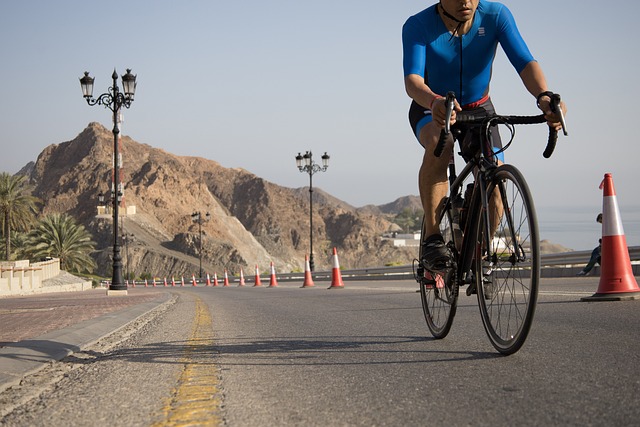
When cycling at night, having a reliable flashlight is paramount for both your safety and the visibility of your surroundings. The ideal 'Flashlights for Night Cycling and Biking' should offer adjustable brightness to conserve battery when navigating easier trails and increase illumination as needed on more challenging ones. They should feature a mix of spot and flood lighting to ensure you can see potential obstacles clearly and maintain awareness of your immediate environment. Durability, water resistance, and robust construction are essential to protect against the elements and trail conditions. A rechargeable battery or the ability to use replaceable batteries will prevent unexpected power loss, ensuring your light source remains reliable throughout your journey. Proper placement on your bike or helmet, at eye level, is crucial for optimal light distribution ahead of you. By choosing a flashlight that meets these criteria, you'll enhance your confidence and safety while transforming your night biking adventure into a memorable experience under the stars.
Embarking on a night cycling or biking adventure requires more than just the thrill of the journey—it demands thoughtful preparation, particularly concerning visibility and safety. As the sun dips below the horizon, trails transform, and hazards such as rocks, roots, and uneven terrain become less discernible. This article illuminates the critical role flashlights play in ensuring night cyclists can spot potential dangers on their paths. We’ll explore key features of top-rated flashlights for night cycling and biking, detail strategies for optimal lighting, and delve into the science behind selecting the right beam pattern and brightness. Additionally, we’ll address the importance of battery life in supporting long-duration excursions and provide best practices for utilizing flashlights effectively on night rides. Prepare to transform your trail experience with informed choices and enhanced safety measures.
- Understanding the Importance of Visibility for Night Cyclists and Bikers
- Key Features to Look for in a Flashlight for Trail Biking at Night
- Top-Rated Flashlights for Enhanced Safety on Night Rides
- Strategies for Effective Lighting on Your Bike for Optimal Hazard Detection
- The Role of beam patterns and brightness in Identifying Trails Hazards
- Battery Life Considerations for Long-Duration Night Cycling Excursions
- Best Practices for Using Flashlights While Navigating Trails at Night
Understanding the Importance of Visibility for Night Cyclists and Bikers

When traversing trails at night, visibility becomes a critical factor for cyclists and bikers. A flashlight is indispensable for such activities, enhancing both the rider’s own visibility to traffic and the environment’s visibility to them. Flashlights for night cycling and biking are designed to cast a beam that can illuminate paths, detect obstacles, and signal other road users. The right flashlight not only extends your ride into the dark without compromising safety but also helps in spotting potential hazards such as potholes, wildlife crossing points, or uneven terrain. It is essential for cyclists to invest in a reliable light source that offers a balance between brightness and battery life to avoid being caught off-guard in low-light conditions.
Moreover, the placement of the flashlight on your bicycle matters; mounting it handlebar-wise can help in directing the light where you look, which is crucial when navigating trails at night. A high-quality flashlight for night cycling and biking should also be versatile, with adjustable brightness settings to conserve energy during less demanding stretches of the trail and increase lumens when encountering challenging sections. The best models are those that offer a consistent light output, are durable enough to withstand the elements, and can be easily recharged or powered by replaceable batteries. This ensures that cyclists have an uninterrupted source of illumination during their night-time expeditions, making them safer and more confident on the trail.
Key Features to Look for in a Flashlight for Trail Biking at Night

When embarking on night cycling or biking adventures, the right flashlight becomes an indispensable tool for safety and navigation. A high-quality flashlight for trail biking at night, often termed as ‘flashlights for night cycling and biking,’ should possess several key features to enhance visibility and ensure a secure experience. Firstly, consider the beam type; a focused spotlight is ideal for scanning ahead and identifying potential hazards like rocks, roots, or abrupt trail changes. This concentrated beam allows riders to illuminate distant areas without overwhelming their night vision. Additionally, a floodlight feature can be beneficial for broader peripheral lighting, providing more visibility of the surrounding environment and nearby obstacles.
Durability is another critical aspect, as trails can present rough terrain. A flashlight designed for night cycling and biking should be constructed with impact-resistant materials, such as aircraft-grade aluminum or a robust rubber casing, to withstand falls or accidental drops without compromising functionality. Furthermore, water resistance is paramount, especially when conditions are wet. A waterproof design ensures the flashlight continues to operate even in challenging weather conditions, safeguarding both the rider and the light itself. Battery life is also a significant factor; opt for lights with long-lasting rechargeable batteries or models that support disposable battery types, so you’re not left in the dark when navigating trails under the night sky. Lastly, adjustability in brightness settings allows riders to conserve power on less demanding stretches and enhance visibility during more technical segments of the trail. With these features in mind, a flashlight for night cycling and biking will serve as a dependable companion for an enjoyable and safe nighttime biking experience.
Top-Rated Flashlights for Enhanced Safety on Night Rides

Strategies for Effective Lighting on Your Bike for Optimal Hazard Detection

When cycling at night, reliable lighting is paramount for both your safety and the detection of potential hazards on the trail. A high-quality flashlight designed for night cycling can significantly enhance your visibility and alertness to surroundings that may be obscured by darkness. Opt for a flashlight with a durable, waterproof construction to ensure it remains operational in all weather conditions. Additionally, consider a light with an adjustable beam focus; this feature allows you to switch between a wide, peripheral illumination for general trail navigation and a narrow, targeted spotlight for pinpointing obstacles or changes in the path ahead. The best flashlights for night cycling offer multiple modes, including steady beams for long-distance visibility and flashing patterns that can improve your conspicuity to motorists and other trail users. Proper placement of your flashlight is also crucial—mount it securely on your helmet or handlebars at a height and angle that aligns with your line of sight. This positioning ensures that the light casts directly in front of you, not beneath your wheels or above your eye level, providing clear illumination where it’s needed most. By integrating a dependable flashlight into your night cycling gear, you can ride with confidence, knowing that you are well-equipped to identify and avoid hazards, thereby enhancing both your safety and the enjoyment of your nighttime rides.
The Role of beam patterns and brightness in Identifying Trails Hazards

When navigating trails at night, cyclists rely heavily on their flashlights to illuminate the path ahead and identify potential hazards. The beam patterns of flashlights designed for night cycling and biking are crucial in ensuring visibility of both immediate obstacles and distant threats. A focused spotlight is indispensable for pinpointing rocks, roots, or uneven terrain that could cause a rider to lose control. Conversely, a wider flood beam allows riders to see the trail edges and surrounding environment, which is particularly important in forested areas where trails can narrow or turn abruptly. The balance between spot and flood beams in a flashlight can significantly enhance safety by providing a comprehensive view of the trail’s condition.
Brightness is another vital aspect to consider when selecting a flashlight for night cycling and biking. High lumen output ensures that even the smallest details, like loose gravel or a slippery patch of mud, are clearly visible from afar. However, an excessively bright beam can lead to glare and diminish peripheral vision. Therefore, it’s important to select a flashlight with adjustable brightness settings. This feature allows cyclists to tailor the intensity to their immediate needs, whether it’s scanning the trail ahead at a lower setting or temporarily increasing brightness to identify an imminent hazard. The right combination of beam pattern and brightness can transform night riding from a risky endeavor into a safe and enjoyable experience. Flashlights for night cycling and biking are not just tools; they are essential safety equipment that deserves careful consideration based on the specific conditions of the trail and the cyclist’s preferences.
Battery Life Considerations for Long-Duration Night Cycling Excursions

When embarking on long-duration night cycling excursions, the reliability of your flashlight’s battery life becomes a pivotal aspect of safety and enjoyment. It’s imperative to select a flashlight designed specifically for night cycling and biking, as these models often feature high-output LEDs and advanced battery management systems that maximize energy efficiency while providing ample illumination to spot hazards on trails. These systems not only enhance visibility of obstacles ahead but also minimize the frequency with which you’ll need to replace or recharge batteries during your ride, ensuring continuous operation when you most need it. Battery life considerations should encompass the flashlight’s battery capacity, the type of batteries it uses, and the ability to easily swap out power sources without interrupting your journey. Optimal flashlights for night cycling and biking often come with rechargeable lithium-ion batteries or disposable alkaline options that offer long-lasting performance, complemented by features such as variable brightness settings and energy-saving modes to extend battery life even further. These features are crucial for riders who plan to cycle through the night, as they provide a dependable light source without the inconvenience of frequent battery changes or the risk of being left in darkness due to a sudden power depletion.
Best Practices for Using Flashlights While Navigating Trails at Night

When embarking on night cycling or biking expeditions, the use of a reliable flashlight is paramount for both safety and visibility. A high-quality flashlight with adjustable brightness settings can illuminate trails effectively, allowing you to spot potential hazards such as roots, rocks, and ruts that could otherwise cause accidents. It’s advisable to select a flashlight designed specifically for outdoor activities; these models often feature durable construction and impact resistance, ensuring they remain operational even when the trail becomes technical.
To maximize the effectiveness of your flashlight during nighttime biking, consider attaching it securely to your helmet or handlebars at an angle that casts light where you’re looking, not where you’ve been. This technique, known as “scanning,” helps in detecting obstacles ahead and reacting promptly. Additionally, always carry spare batteries or a charging source for your flashlight. Regularly test your flashlight before setting out on your ride to ensure it’s functioning correctly; this proactive approach can prevent a nighttime trail excursion from turning into an unsavory adventure. Proper usage of flashlights for night cycling and biking involves not only selecting the right equipment but also preparing for various scenarios that darkness may present. Safe navigation through trails at night relies heavily on the right lighting tools and the foresight to be prepared for whatever the darkened path may reveal.
When embarking on night cycling or biking excursions, safety and visibility are paramount. A reliable flashlight tailored for trail biking not only illuminates the path ahead but also enhances the detection of potential hazards, ensuring a safer journey. The key features of such a flashlight include a focused beam pattern, sufficient brightness, and long-lasting battery life to endure the duration of your ride. By integrating the strategies outlined in this article for effective lighting and understanding the importance of these features, you can confidently navigate trails at night. In conclusion, investing in a high-quality flashlight specifically designed for night cycling and biking is an essential step in promoting safety and enjoyment on your nocturnal adventures.







